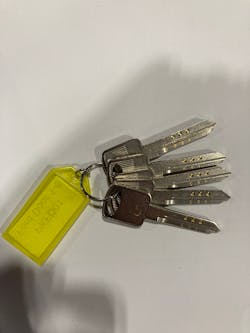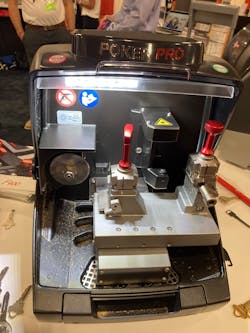Locksmiths have to have an array of tools to help them get the job done right every time.
These typically can be separated into two groups:
- Standard tools that everyone who works in a trade uses — screwdrivers, drills, saws, etc.
- Tools that are unique to the locksmithing trade. These include key machines, picks and jigs.
2022 was a good year for tools for the trade, with a number of releases aimed at helping locksmiths while on the job. (That said, we’re aware of a few tools that also got caught up in supply-chain disruption, so the problems weren’t unique to makers of locks and door hardware.)
Below is a roundup of the tools that impressed us:
Autel MaxiIM KM100 and IKEYs
Autel in 2022 entered the “Universal Smart Key” market with its MaxiIM KM100 tool and line of IKEY fobs. The fobs, while certainly not truly universal, can be programmed to emulate an amazing variety of vehicle prox fobs and flip keys and are available in many forms, some of which are almost indistinguishable from the various OEM fobs.
The MaxiIM KM100 programmer, which is capable of smart-key creation, obviously is produced in conjunction with Xhorse’s equipment, because many of the menus and functions of the KM100 are virtually identical to the same functions on the Key Tool Max, but the KM100 delivers much more programming capability.
The KM100 has a 5.5-inch touchscreen, AutoVin vehicle identification and a simple user face that includes concise instructions. The tablet comes with 64GB of memory and a long-lasting rechargeable battery.
A variety of OEM look-alike IKEY fobs have been announced but aren’t in wide supply. But, soon, look-alike fobs will be available to customers at attractive prices.
More info: www.auteltech.com
Framon Bullseye Installation Jig
Sometimes, what’s old is new again. In 2022, however, it was a completely new tool for locksmiths.
The Framon Bullseye Installation Jig is a mortise jig that will help locksmiths when they drill wood or metal doors. It has a 1-1/2-inch cross bore that has removable caps that expand the width to 2-1/8 inches after using a 3/32-inch allen wrench (not included). The jig’s backset is 2-3/8 inches or 2-3/4 inches, and it adjusts instantly by using built-in tabs. The jig works with doors that are 1-1/4–2-3/4 inches thick.
If such a tool sounds familiar to you, that isn’t a coincidence. Phil Agius, vice president of marketing and sales at Framon, says the tool is a direct replacement for the A-1 Bulls Eye, which is why, he says, “We’re calling it a Bullseye.” The original Bulls Eye has been out of production since A-1 closed its doors nearly a decade ago.
But Agius says Framon isn’t just copying the dearly departed installation jig; it’s improving it by adding 1/8-inch pilot holes at the jig’s 12- and 6-o’clock positions. The holes are for through bolts for levers that use 2-3/4-inch spacing.
“We didn’t reinvent the wheel,” Agius says. “We just brought back a really good tool.”
More info: www.framon.com
Framon Push Keys
Like many automotive locksmiths, Thomas Thill ran into trouble one day on the job. Thill, who is in charge of education and training at Transponder City, an automotive locksmith shop in the Chicago suburb of Bridgeview, Illinois, came up with “a better way” to decode and unlock Toyotas that had an eight-cut ignition, as well as hundreds of other vehicles: the Push Key.
Now, through a relationship with Framon Manufacturing, Thill’s method for decoding automotive wafer locks has arrived to the masses.
Push keys are a way to decode cylinders and cut keys for automotive locks without taking apart the lock cylinder. A push key is a marked key blank that has a tiny notch cut into the tip at various depths depending on the keyway. When inserted into a cylinder that has wafer tumblers, the notch makes contact with a wafer or not depending on the wafer’s depth.
“That wafer is going to slide along the angle of the key,” Thill explains. “When you get a ‘hit’ into that little notch, it will be enough to give a little bump and say, ‘hey, there’s something here’ but not enough to jam the key up completely so you can move throughout the lock.”
Depending on the location of the notch, those hits will provide the height of the wafer and, thus, the depth of the corresponding key cut.
In addition to the notch, the push key also has a series of markings and numbers along the side of the blade that allow you to identify the wafer position in the cylinder when you have a hit as you insert the key.
Thill uses a set of five push keys to decode a seven-cut ignition lock on a Ford van, where the first position is empty. His push keys have color-coded markings for positions 2, 4, 6 and 8 on one side of the key blade and 3, 5 and 7 on the other.
Starting with the No. 1 depth push key, Thill gets hits on all seven positions. After jotting down marks on his key grid, Thill moves to the No. 2 key, noting hits on positions 2 through 6 and then 8, before proceeding to No. 3 and so on until he identifies a code of X5544312 for that particular ignition. By putting the odd-number locations on one side and even numbers on the other, Thill then can cut a key that turns the ignition.
Push keys are similar to Lishi 2-in-1 tools in the sense that different vehicles and different keyways require their own push keys to operate correctly. In other words, push keys that work on a Ford van won’t work on a Chrysler. Framon is producing only a few series of push keys for Ford vehicles to start.
“It’s a big project,” Agius says. “There are so many different keys you could potentially make.”
More info: www.framon.com
Lock Labs Triton PLUS
The Triton PLUS is an updated version of the original all-in-one Triton, which was released three years ago. Lock Labs says the most important upgrade to the automatic key originator and duplicator was the inclusion of a new robust direct-drive motor and control board that will provide for future capabilities.
The Triton PLUS comes in three editions that differ by the jaws that are included and, thus, the capabilities of the machine:
Commercial Edition: It’s aimed at locksmiths who primarily cut commercial and residential keys and includes an engraving function, which is good for marketing your locksmith business.
Automotive Edition: This edition cuts 99% of contemporary automotive keys out of the box. It includes jaws for cutting Tibbe keys, plastic emergency keys, dimple keys (Nissan) and the latest edge-milled Volkswagen high-security keys. It even will cut new 2022 Honda Civic steel keys, with more to come.
Ultimate Edition: This variation cuts all automotive, commercial and residential keys out of the box and can engrave them, too. It includes every jaw and accessory available. One particularly notable facet is the inclusion of a new Flip Blade Creation Jaw that allows you to convert mechanical key blanks into Xhorse or KeyDIY remote head keys, flip keys or emergency keys.
The machine itself and the operation are the same for all three models. Locksmiths who choose either the Commercial or Automotive editions can buy additional jaws to increase the capability of their machine later.
More info: tritonkeymachine.com
Silca Poker Pro
The Silca Poker Pro is the latest automatic duplicator from Kaba Ilco, and the name of the game for this machine is simplicity.
The Poker Pro was designed to make key duplication “as easy as it gets,” says Ryan McGee, product manager of key systems for Kaba Ilco. “It fills a gap that we have for our electronic key machine lineup by providing a machine that can duplicate keys electronically without the additional features and capabilities of our other electronic machines.”
The Poker Pro resembles the brand’s high-end automatic Futura line and in fact is built on the Futura platform, in much the same way that certain vehicles by the same manufacturer are built on the same platform. This makes for speedier and lower cost assembly.
But that’s where the similarities end, because although the Futura key machines are meant to handle a number of tasks for multiple types of keys, the Poker Pro has one job: automatic duplication of flat edge-cut (single- or double-sided) or cruciform keys.
Reading and cutting the key are performed simultaneously, which decreases the total time to duplicate keys. The Poker Pro uses a laser reader, and the lack of a tracer point means no contact with the machine, which protects the customer’s original key.
“It mimics exactly the key being copied, including the wear, which is good, because that also mimics exactly the wear in the cylinder,” McGee says.
He adds that the Poker Pro is aimed particularly at new locksmiths because of its operating simplicity. All you do to cut a key is insert the key in the clamp, using the shoulder stop to line up the key correctly, before doing the same with the key blank in the other clamp and pressing the green Start button. The machine does the rest.
An LED in the cutting area shines blue during the cutting, green when the key is cut and red if a problem stops the machine, such as if the shield were raised inadvertently during cutting.
More info: www.ilco.us








